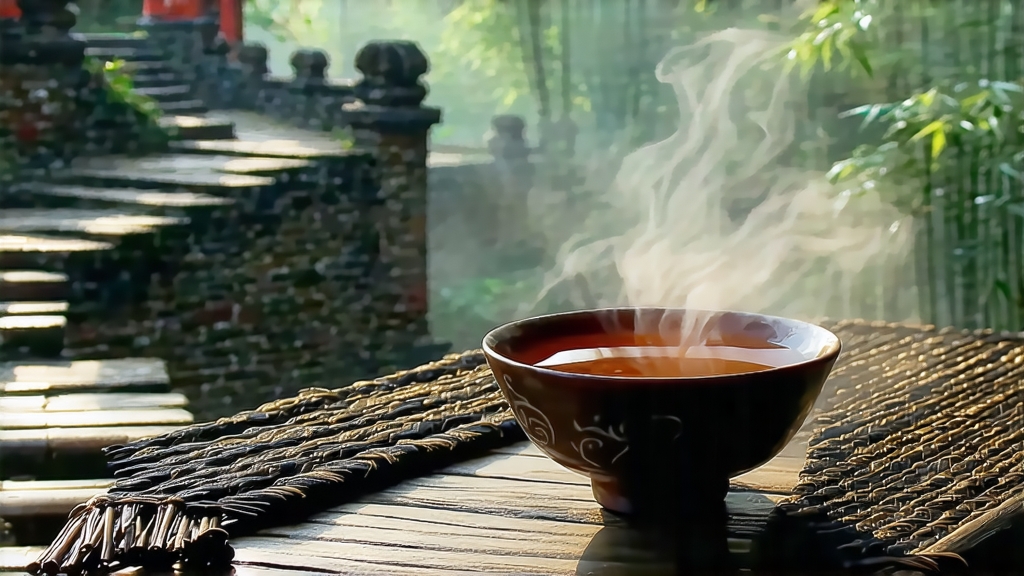
Tucked into the subtropical folds of Guangxi’s Wuzhou prefecture, Liupu tea (often written Liu Bao) is the quietest celebrity of China’s dark-tea family. While Pu-erh hogs the spotlight, Liupu has spent four centuries perfecting the art of subtlety, turning the humid breath of the southern mountains into a liquor that tastes like drinking antique mahogany. To meet it is to step into a micro-climate where geography, microbiology and human patience collide.
-
From border garrison to global cup
The story begins in the Ming-era military garrison of Liupu town, a compulsory waypoint on the “Tea-Horse Road” that fed warhorses in exchange for Central-Plains tea. Caravans noticed that the rough green tea pressed into bamboo baskets improved after weeks of monsoon travel. By the Qing dynasty the transformation was deliberate: tea was trucked to humid Hong Kong warehouses where it fetched higher prices the darker it became. Thus a logistics accident became a style, and Liupu earned imperial tribute status in 1792. Today the same baskets fly business class to Kuala Lumpur, Johannesburg and Vancouver, following the Cantonese diaspora who refuse to dim-sum without its digestif punch. -
One name, many faces
Liupu is not a single leaf but a spectrum of post-fermentation. At the pale end are “light-wet-pile” cakes (30 % moisture, 25 days) that retain chestnut and orchid notes; at the ebony extreme are “double-fermented” bricks (60 % moisture, 90 days) that ooze camphor and betel nut. Between them lie basket-aged, jar-aged, cave-aged and the rare “dragon-boat” bricks pressed in 1976 for export to Macau casinos. Age statements follow Guangxi convention: “Chen Xiang” (3–7 years), “Lao Cha” (8–20), “Gu Cha” (21–40), and “Cha Gu” (pre-1980, literally “tea bones”). -
Crafting controlled rot
Harvest follows the lunar calendar: one bud-two leaves plucked before Qingming for fragrance, after Guyu for body. The kill-green wok is cooler (180 °C) than that for green tea, leaving enzymes alive. Rolling is brief to keep stems intact; these act as straws for oxygen later. Sun-drying on bamboo screens takes only 40 minutes—just enough to hit 45 % moisture—before the pivotal “wet pile” (wo dui). Leaves are heaped 70 cm high, sprayed with mountain spring water, and covered with jute. Inside the stack thermophilic bacteria (Bacillus subtilis, Aspergillus niger) raise the temperature to 55 °C; every three days the pile is turned, aerated and re-sprayed. After 30–50 days the leaf turns walnut-brown and acquires the signature “betel-nut” aroma. Post-pile, the tea is steamed, pressed into 40 kg bamboo baskets lined with banana leaves, and transferred to the famous “National Liupu Storage Cave,” a decommissioned limestone tunnel whose relative humidity hovers at 85 %. Here it hibernates for years, trading sharpness for depth the way a violin collects soul in a case. -
Brewing the invisible
Because Liupu is already “cooked,” it forgives almost any abuse, yet rewards precision. Start by “waking the dragon”: rinse 5 g of leaf in a gaiwan with 100 °C water for three seconds, discard. First infusion 15 s, second 10 s, third 20 s, then add five seconds each steep. A yixing pot thickens texture, but porcelain keeps the high notes. For grandpa style, drop 2 g into a travel flask and refill all day; the sweetness migrates to the back of the tongue while the front remains mineral-dry. In Malaysia’s kopitiams the same leaves are boiled with pandan leaves and condensed milk, yielding a caramel-colored “cha cham” that cuts through coconut rice. -
Tasting the mountain’s memory
Professional cupping follows Guangxi’s “three breaths” rule. First breath—smell the empty gaiwan lid: wet limestone, hint of longan. Second breath—slurp, aerate, let